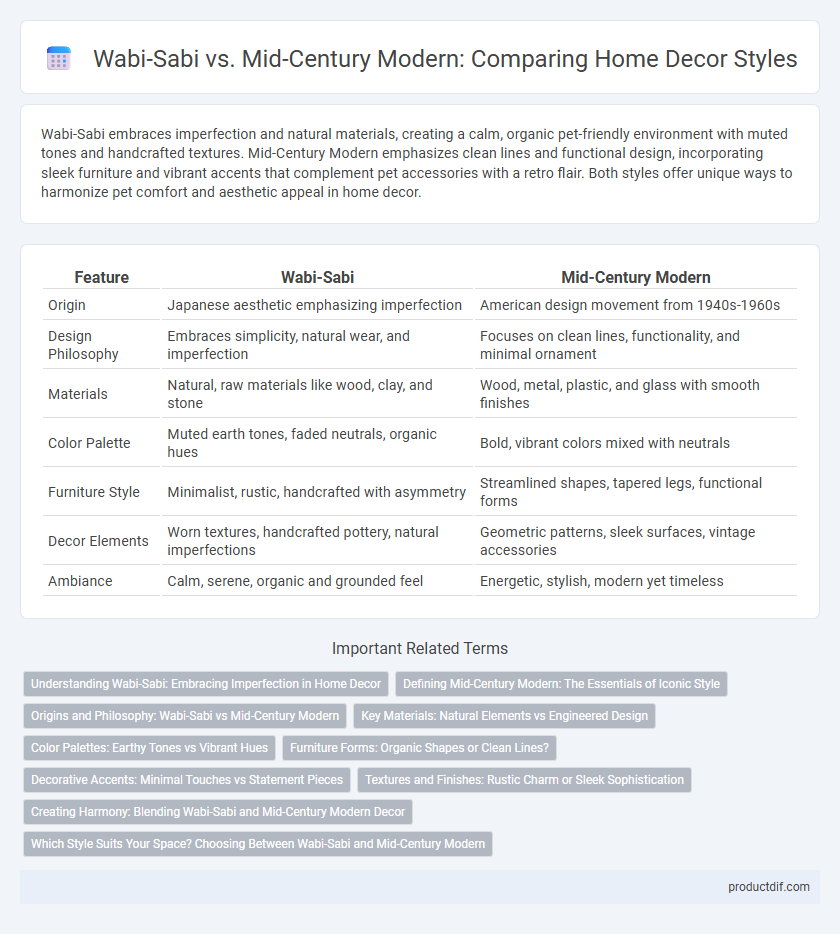Wabi-Sabi embraces imperfection and natural materials, creating a calm, organic pet-friendly environment with muted tones and handcrafted textures. Mid-Century Modern emphasizes clean lines and functional design, incorporating sleek furniture and vibrant accents that complement pet accessories with a retro flair. Both styles offer unique ways to harmonize pet comfort and aesthetic appeal in home decor.
Table of Comparison
| Feature | Wabi-Sabi | Mid-Century Modern |
|---|---|---|
| Origin | Japanese aesthetic emphasizing imperfection | American design movement from 1940s-1960s |
| Design Philosophy | Embraces simplicity, natural wear, and imperfection | Focuses on clean lines, functionality, and minimal ornament |
| Materials | Natural, raw materials like wood, clay, and stone | Wood, metal, plastic, and glass with smooth finishes |
| Color Palette | Muted earth tones, faded neutrals, organic hues | Bold, vibrant colors mixed with neutrals |
| Furniture Style | Minimalist, rustic, handcrafted with asymmetry | Streamlined shapes, tapered legs, functional forms |
| Decor Elements | Worn textures, handcrafted pottery, natural imperfections | Geometric patterns, sleek surfaces, vintage accessories |
| Ambiance | Calm, serene, organic and grounded feel | Energetic, stylish, modern yet timeless |
Understanding Wabi-Sabi: Embracing Imperfection in Home Decor
Wabi-Sabi home decor embraces imperfection through natural materials, muted colors, and handcrafted items that highlight asymmetry and weathered textures, creating a serene and authentic living space. This aesthetic contrasts with Mid-Century Modern's emphasis on sleek lines, minimalism, and functionalism, focusing on polished wood and geometric shapes. By valuing simplicity and impermanence, Wabi-Sabi offers a warm, organic atmosphere that celebrates life's transient beauty and uniqueness.
Defining Mid-Century Modern: The Essentials of Iconic Style
Mid-Century Modern design emphasizes clean lines, functional forms, and integration with nature, characterized by organic shapes, minimalist aesthetics, and use of natural materials like teak and walnut. Iconic elements include sleek furniture with tapered legs, geometric patterns, and a color palette featuring earth tones combined with bold accent colors. This style prioritizes simplicity and practicality, creating timeless interiors that blend comfort with innovative design.
Origins and Philosophy: Wabi-Sabi vs Mid-Century Modern
Wabi-Sabi originates from Japanese Zen Buddhism, emphasizing imperfection, impermanence, and simplicity as reflections of natural beauty and tranquility. Mid-Century Modern emerged in the mid-20th century, rooted in post-World War II optimism with a focus on minimalism, functionality, and clean lines inspired by Scandinavian and Bauhaus design. These distinct philosophies shape their contrasting aesthetics: Wabi-Sabi values rustic, organic textures, while Mid-Century Modern prioritizes sleek, geometric forms and innovative materials.
Key Materials: Natural Elements vs Engineered Design
Wabi-Sabi embraces natural elements such as raw wood, stone, bamboo, and handmade ceramics to highlight imperfection and organic beauty, fostering a rustic, earthy ambiance. Mid-Century Modern favors engineered materials like molded plywood, fiberglass, steel, and plastic, emphasizing sleek lines and functional forms that reflect technological innovation and mass production. While Wabi-Sabi celebrates the authenticity of natural textures and weathered surfaces, Mid-Century Modern prioritizes precision, smooth finishes, and industrial aesthetics.
Color Palettes: Earthy Tones vs Vibrant Hues
Wabi-Sabi embraces earthy tones such as muted browns, soft greens, and warm beiges, emphasizing natural materials and understated elegance. Mid-Century Modern features vibrant hues like bold oranges, teals, and mustard yellows, creating a dynamic and energetic atmosphere. The contrast between Wabi-Sabi's calming palette and Mid-Century Modern's lively colors highlights distinct aesthetic philosophies in home decor.
Furniture Forms: Organic Shapes or Clean Lines?
Wabi-Sabi furniture embraces organic shapes with natural imperfections that highlight simplicity and authenticity, often featuring raw wood and asymmetrical designs. Mid-Century Modern furniture favors clean lines, geometric forms, and functional silhouettes, emphasizing minimalism and sleek profiles. Choosing between the two styles depends on whether you prefer the warm, imperfect aesthetic of Wabi-Sabi or the precise, polished look typical of Mid-Century Modern design.
Decorative Accents: Minimal Touches vs Statement Pieces
Wabi-Sabi decor embraces minimal touches with natural, imperfect accents such as handcrafted ceramics and weathered wood, highlighting simplicity and organic beauty. Mid-Century Modern style favors bold statement pieces like sleek geometric lamps, vibrant rugs, and iconic furniture silhouettes that serve as focal points in a room. While Wabi-Sabi promotes understated elegance through subtle, textured elements, Mid-Century Modern celebrates striking design and vivid colors that energize spaces.
Textures and Finishes: Rustic Charm or Sleek Sophistication
Wabi-Sabi embraces natural textures and imperfect finishes, highlighting raw wood grains, weathered surfaces, and organic materials to create a rustic charm that celebrates imperfection. Mid-Century Modern features smooth, polished finishes and sleek textures like walnut veneer, lacquered surfaces, and minimalist upholstery to evoke a sophisticated and streamlined aesthetic. The contrast between Wabi-Sabi's tactile warmth and Mid-Century Modern's refined sleekness defines their unique approaches to home decor.
Creating Harmony: Blending Wabi-Sabi and Mid-Century Modern Decor
Blending Wabi-Sabi and Mid-Century Modern decor creates harmony by balancing organic imperfection with sleek geometry, emphasizing natural materials like wood and ceramics alongside clean lines and functional furniture. This fusion highlights textures such as raw wood, linen, and stone, complementing iconic Mid-Century Modern pieces like the Eames lounge chair or teak sideboards. Incorporating neutral earthy tones and minimalist design principles fosters a serene, warm space that honors both the beauty of imperfection and timeless elegance.
Which Style Suits Your Space? Choosing Between Wabi-Sabi and Mid-Century Modern
Wabi-Sabi embraces natural imperfections and simplicity, ideal for creating a calming and organic atmosphere in spaces seeking tranquility and authenticity. Mid-Century Modern features clean lines, functional furniture, and bold geometric forms, perfect for rooms that prioritize sleek design and retro-inspired elegance. Assess your space's lighting, architectural elements, and personal comfort preferences to determine whether the warm, rustic charm of Wabi-Sabi or the structured, vibrant aesthetic of Mid-Century Modern complements your lifestyle best.
Wabi-Sabi vs Mid-Century Modern Infographic

 productdif.com
productdif.com